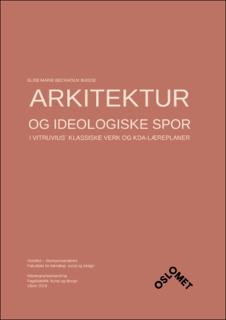| dc.contributor.advisor | Lefdal, Else Margrethe (hovedveileder) | |
| dc.contributor.advisor | Brodshaug, Irene (biveileder) | |
| dc.contributor.author | Bugge, Elise Marie Bechholm | |
| dc.date.accessioned | 2021-06-29T13:11:47Z | |
| dc.date.available | 2021-06-29T13:11:47Z | |
| dc.date.issued | 2019 | |
| dc.identifier.uri | https://hdl.handle.net/11250/2762379 | |
| dc.description.abstract | Denne fagdidaktiske masteravhandlingen har en teoretisk tilnærming og fokus på fagområdet arkitektur. Undersøkelsen tar utgangspunkt i følgende problemstilling:
Hvordan kan læreplanene i Kunst, design og arkitektur (KDA) fortolkes gjennom Vitruvius´ klassiske verk? Hva kan fortolkningen synliggjøre av ideologiske spor om fagområdet arkitektur?
Det studieforberedende utdanningsprogrammet Kunst, design og arkitektur i videregående opplæring, skal forberede elevene til videre utdanning innen arkitektur. I den sammenheng er det derfor interessant å undersøke om det er mulig å synliggjøre ideologiske spor i utdannings-programmets læreplaner, som kan førest tilbake til antikken og Vitruvius´ verk - De arcitectura libri decem. Verket er det eneste bevarte verket som omtaler arkitektur fra antikken. Fordi empiri-grunnlaget i denne undersøkelsen hentes fra skriftlige dokumenter, som krever fortolkning, har undersøkelsen et hermeneutisk vitenskapelig ståsted. Dokumentanalyse er brukt som metode for å fortolke den danske oversettelsen av Vitruvius´ klassiske verk, og den samme metoden er brukt for å fortolke læreplanene i utdannings¬programmet Kunst, design og arkitektur (KDA), med fokus på arkitektur.
Gjennom analyse og fortolkning av Vitruvius´ verk fremkom de sentrale prinsippene: brukbarhet (utilitas), holdbarhet (firmitas), skjønnhet (venustas) og betydningen av arkitekturhistorie. Og disse prinsippene dannet så utgangspunkt for analyse og fortolkning av læreplanene. Analysen av KDA læreplanene er gjort på et vedtattnivå og tolkningsnivå i tråd med Nielsen (2009) sin videreutvikling av Goodlads Curricula. De to analysene danner grunnlaget for fagdidaktiske refleksjoner på et ideologisknivå, rundt hvordan arkitektur fremstår i KDA, samtidig som refleksjoner rundt samfunn-saktuelle temaer trekkes inn. Undersøkelsen viser at det kan er ideologiske spor som stammer fra antikken og Vitruvius´ verk, men at de fremkommer i noe ulik grad i de ulike læreplanene i utdanningsprogrammet.
Undersøkelsen inneholder også en praktisk-estetisk del som skal fungere som en kommentar til problemstillingen og undersøkelsens funn. Dette arbeidet presenteres i metodedelen og i et eget kapittel. Det praktisk-estetiske arbeidet stilles ut på en felles masterutstilling ved OsloMet i mai 2019. | en_US |
| dc.description.abstract | This didactic master thesis has a theoretical approach with a focus on the Architectual Field. The study originates from the following topic question:
How can the Curriculum in Art, design and architecture (KAD) be interpreted through Vitruvius’ classical treatise? What can this interpretation visualize of ideological traces in the subject of architecture?
The study preparation program Art, Design and Architecture in high school will prepare students for further education in architecture. Within this context it will be interesting to examine the possibility of detecting ideological traces in the Architectual Field, originating from the Antique and Vitruvius’ treatise – De arcitectura libri decem. This treatise is the only preserved work that reviews antique architecture. Since the empiricism for this examination is collected from written documents which require interpretation, the examination has a hermeneutical scientific Theory. Document¬analysis is the used method for interpretation of the Danish translation of Vitruvuis’ classical treatise, and the same method is used for interpretation of the curriculum in the study preparation program Art, design and architecture, focusing on architecture.
Through analysis and interpretation of Vitruvius´ treatise, these key principles emerged: usability, (utilitas), durability (firmitas), beauty (venustas) and the the importance of architectural history. These principles then formed the basis for the analysis and interpretation of the curricula. The analysis of the KDA Curricula is completed on the Formal- and Perceived Level. The two analyses form the basis of the didactic reflections on an ideological level regarding how architecture appears in KDA, while at the same time drawing in reflections on social issues. The examination shows there are ideological traces originating from the Antique and Vitruvius’ treatise, yet they emerge somewhat differently within the study program’s.
The Master project also has a practical-estetical part that will function as a comment to the project’s main question, along with the results of the examination. This work is presented in the method chapter and in an own chapter. The practical-estetical work will be presented in an exhibition for the students in the master program at OsloMet in may 2019. | en_US |
| dc.language.iso | nob | en_US |
| dc.publisher | OsloMet - storbyuniversitetet | en_US |
| dc.relation.ispartofseries | MEST;2019 | |
| dc.subject | Fagdidaktikk | en_US |
| dc.subject | Arkitektur | en_US |
| dc.subject | Læreplaner | en_US |
| dc.subject | Utstilingsdesign | en_US |
| dc.title | Arkitektur og ideologiske spor: I Vitruvius´ klassiske verk og KDA-læreplaner | en_US |
| dc.type | Master thesis | en_US |
| dc.description.version | publishedVersion | en_US |
